Meet We{dn}esdays, Digital Nomads Croatia Nationwide Drinks Night
February 13, 2022 - Another milestone of cohesion in Croatia's digital nomad journey, as DNA Croatia announces the first We{dn}esdays Digital Nomads Croatia nationwide drinks events.
After 19 years living in a country famed for its bureaucracy and infighting among interest groups, I am finding the Croatian digital nomad story to be beyond refreshing. So much cohesion and positive energy from talented and motivated stakeholders, who are gelling and forming a focused and cohesive roadmap to develop this new sector and opportunity for the country.
At the heart of everything (at least it seems to me) is the energy of the Digital Nomad Association Croatia - the first of its kind in the world, if I am not mistaken - which is coordinating, connecting, advocating and promoting the sector with vision and energy.
The recent Digital Nomad Reflection Day was the first time all the key stakeholders got to know each other and find out what others are doing in the sector. Four hours on Zoom flew by, and it was one of the best brainstorming sessions I have been part of in my time in Croatia. Read more in Cohesion, Unity & Planning at Croatian Digital Nomad Reflection Day 2022.

The latest landmark on the journey is DNA Croatia's announcement of we{dn}esdays, drinks for digital nomads and friends this Wednesday (16th) from 19:00 in bars in several cities all over the country: Swanky Monkey in Zagreb, The Daltonist in Split, Mama's in Dubrovnik, Beach Bar Bamboo in Zadar, and Rakhia Bar in Rijeka. A chance to meet other nomads, or find out more about the lifestyle if you are interested in becoming one or getting into the nomad tourism sector. There will be special drinks discounts for those coming.
This is the first such event, and it will be repeated. All welcome. I will be raising a glass at Swanky Monkey, which is something I have been known to do there on occasion. So all welcome and please join.
In other news, DNA Croatia has also launched its new Facebook page, which will be powered by the community. You can follow it here.
For more news and features on digital nomads in Croatia, follow the dedicated TCN section.
‘Besides, the Food Is Very Good’: Impressions of Croatia in Travel Journals of Yore (II)
February 5, 2022 - In the second part of the feature exploring impressions of Croatia found in old travel journals, we're retracing the steps of several foreign visitors in Dalmatia.
If you haven't read the first part, please head here to meet our protagonists, fearless adventurers and diligent reviewers, and see what they thought of Istria. We’re picking up where we left off, with all of our esteemed travellers heading further south.
First up, Zadar, the main Venetian base on the Croatian coast back in the day and thus an obligatory stop on every tour of the Adriatic. Very well defined in this succinct statement by archaeologist Jacob Spon who travelled in Dalmatia in 1675:
It’s the capital and one of the best places that the Republic owns in Dalmatia.
He also liked the cathedral and excellent paintings of Titian and Palma displayed in the churches of Zadar, but I’ll spare you the rest of the paragraph as it’s not more than a list of artworks.
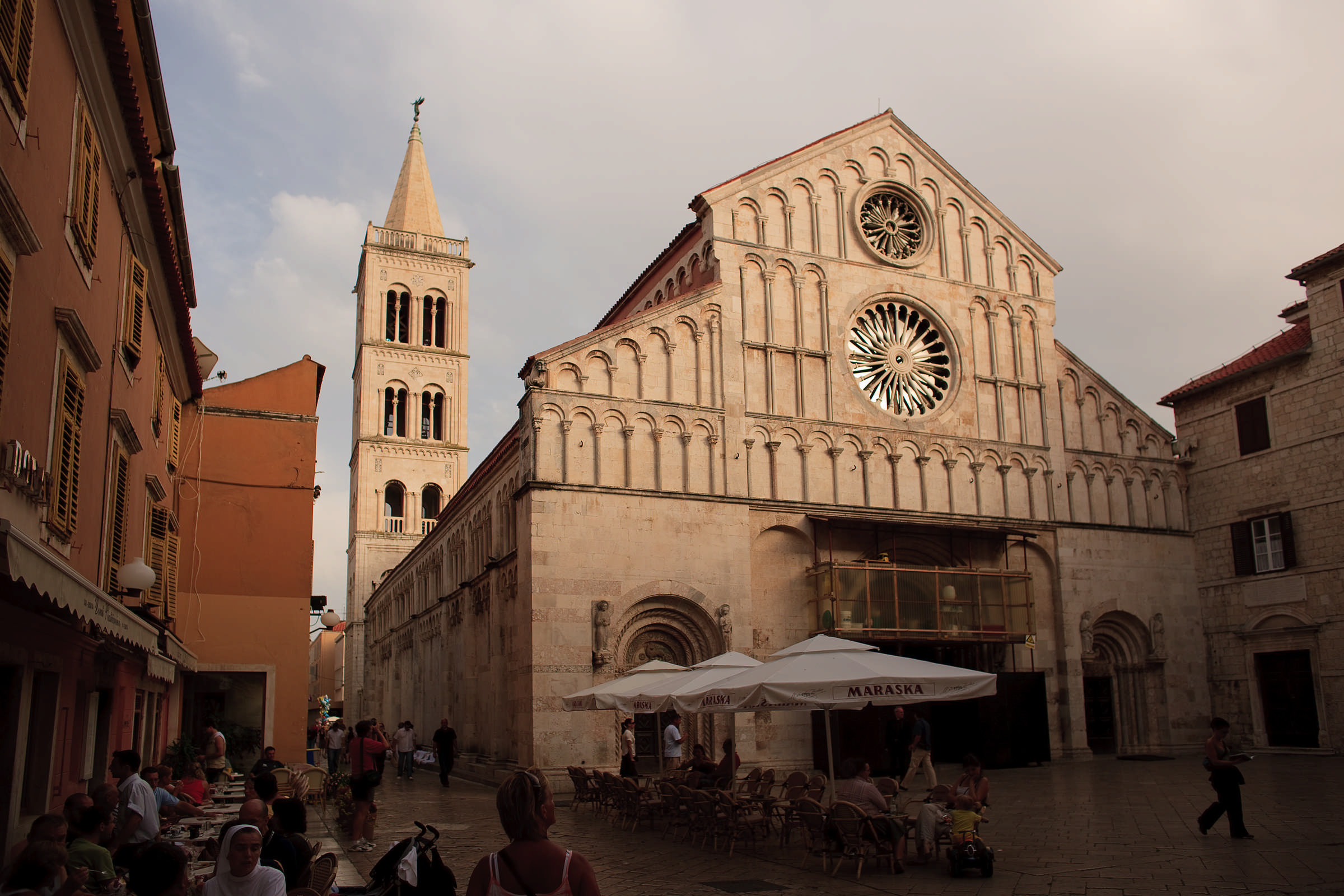 Zadar cathedral by Romulic
Zadar cathedral by Romulic
A few thoughts on Zadar by Noé Bianchi who visited in the 1770s, in his trademark enumeration style:
The city has six gates, a great Arsenal, and many ships and boats. It is a beautiful port, and a place to live in abundance; its territory spans over thirty miles on the mainland, with many castles, islands, and more than four hundred reefs. There are large pastures with plenty of livestock, and an abundance of all sorts of fish; they dress pompously, are very devoted to arms, but above all to humanist studies; they have many schoolmasters, and a lot of merchants.
Let’s hope it was the people of Zadar who dressed pompously and not the fish. Thankfully, we have a new character in our story: countess de La Morinière de La Rochecantin who offers her view of the locals, having visited Zadar in 1907:
The men are not handsome at all; their eyes are hard, their facial features sharp. The women, on the other hand, have a beautiful smile and something seductive under those colourful scarves with which they cover their heads.
Sorry, men of Zadar.
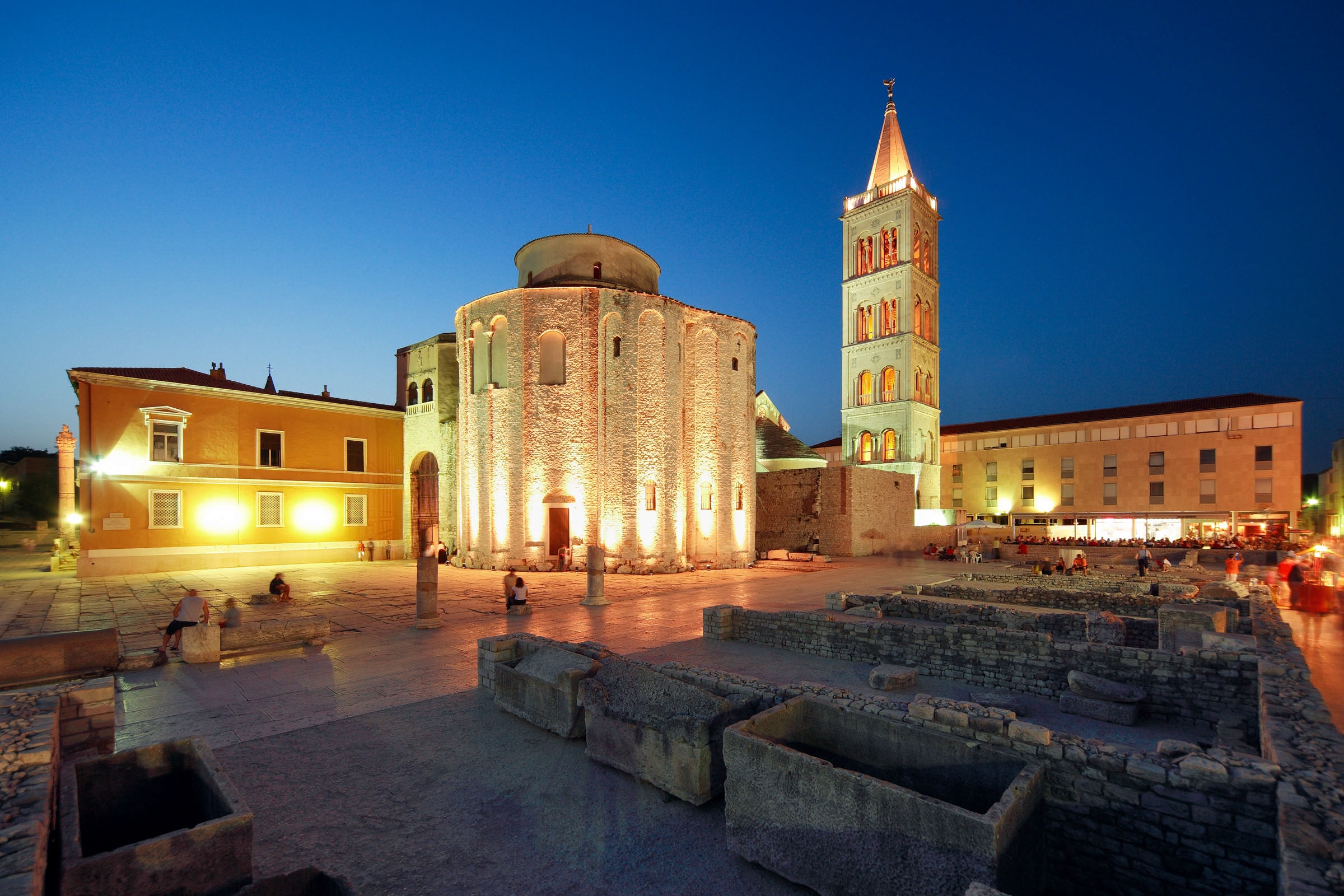 Zadar by Romulic
Zadar by Romulic
***
On we go to Trogir, where the countess notes the following:
The inhabitants are largely similar to those of the Illyrian islands, but this lot is more gentle. They live here in a small Provence. Tamarisk trees and pines, through which a soft wind whistles as if in song, line the narrow paths that run along the shore.
This morning, the water glistens with opal reflections, the air is gentle and warm, but it’s enough for the sky to get veiled in clouds for a feeling of melancholy to take hold of us. In these countries where the sun is king, it alone gives life to beings and things: aromatic plants, trees with pale foliage; the flora of such ardent regions only comes alive and reveals all its splendour and perfumes in the light and under the scorch of the sparkling star.
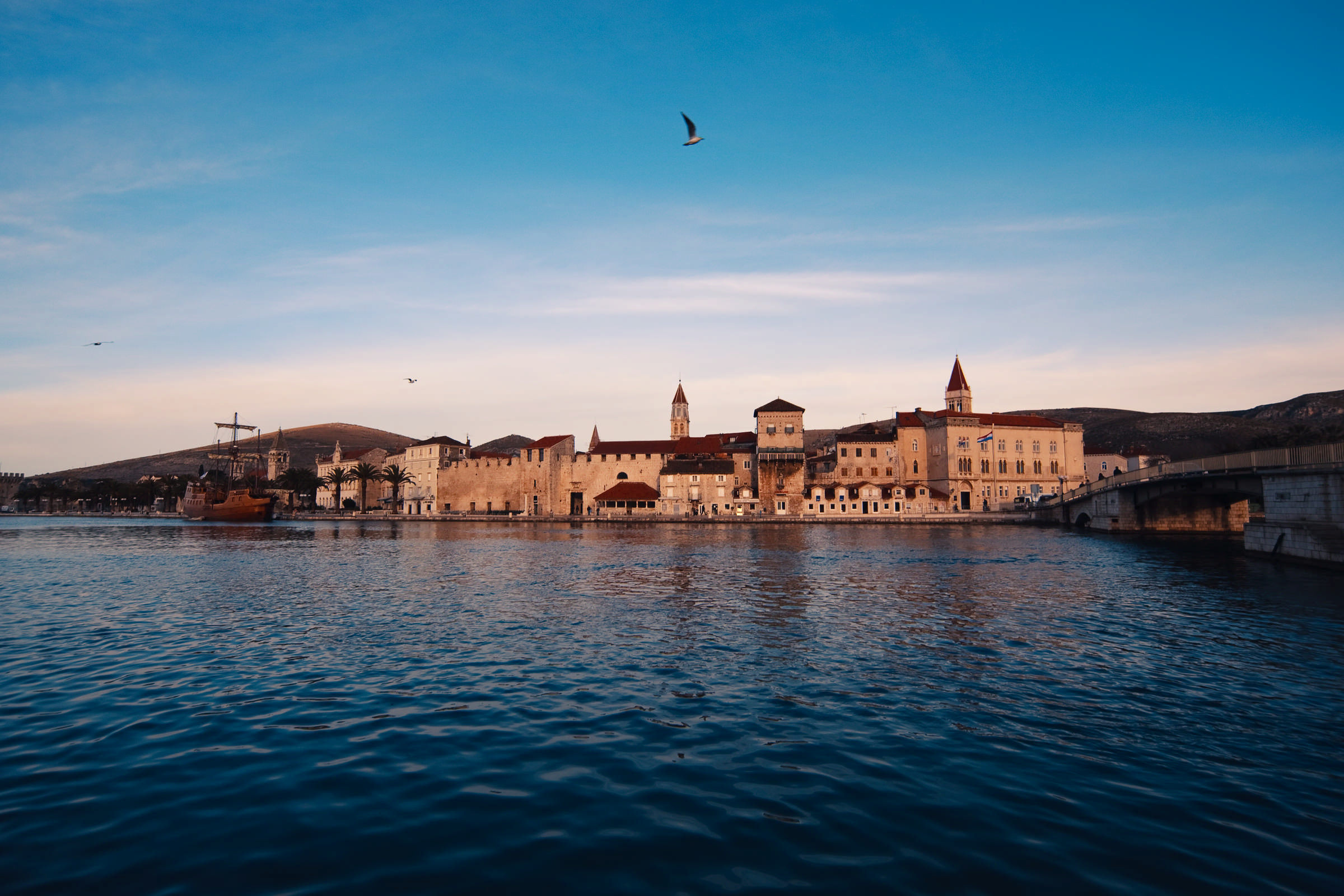 Trogir by Mario Romulic
Trogir by Mario Romulic
Spon on the other hand has a less poetic approach and seems to be excited about Trogir mostly due to it being the birthplace of Ivan Lučić Lucius, a Croatian historian of international renown.
Lucius is known as the father of Croatian historiography owing to his work 'On the Kingdom of Dalmatia and Croatia', in which he gives a comprehensive account of Dalmatia’s history from the Roman times to the end of the 15th century. Seemingly enough to merit admiration from monsieur Spon who, as we’ve learned, wasn’t easily impressed:
This monsieur Lucius is a nobleman from this country whom I had the honour to meet in Rome, where he is now residing. His homeland is indebted to him for having pulled it from the shadows of antiquity with the historic account he made.
 Trogir by Mario Romulic
Trogir by Mario Romulic
Immediately upon arrival, Spon and his party are struck by one of the worst troubles that can happen on a trip: no place to stay!
We had arrived in Trogir at dinner time and were looking for lodging, when we were told that we had to make our own arrangements for dinner, and that it wasn’t customary in that land to deal in hospitality [accommodation].
Naturally, as they were starving at that point, they weren’t exactly happy to hear this, but they got lucky shortly thereafter and found a place in town that sold wine. They were soon ushered into a nearby building that turned out to be none other than Lucius’s palace. This one:
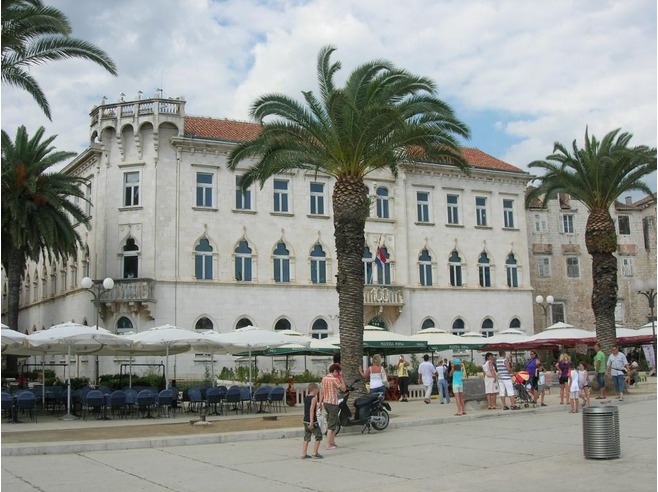
We were surprised to see this house, which is quite beautiful and has a view of the sea, empty and as if deserted, and we were even more surprised when we were told it was the house of this monsieur Lucius whom I just talked about. It has been more than twenty five years since he left it, all because of the incivility of a General of Dalmatia who, having arrived in Trogir, let [Lucius] know he wanted to lodge in his house. The nobleman was getting ready to receive him, and left for himself only a mediocre apartment. But the general immediately sent his people to take all the furniture outside. This impudence annoyed [Lucius] so much, he left the country immediately and never wanted to return.
Loving the gossip. Any thoughts on the sights, though?
The cathedral isn’t ugly. There are some statues in the church, made by a fairly good hand.
Today, the historic centre of Trogir, including the cathedral of St Lawrence, is a UNESCO World Heritage Site.
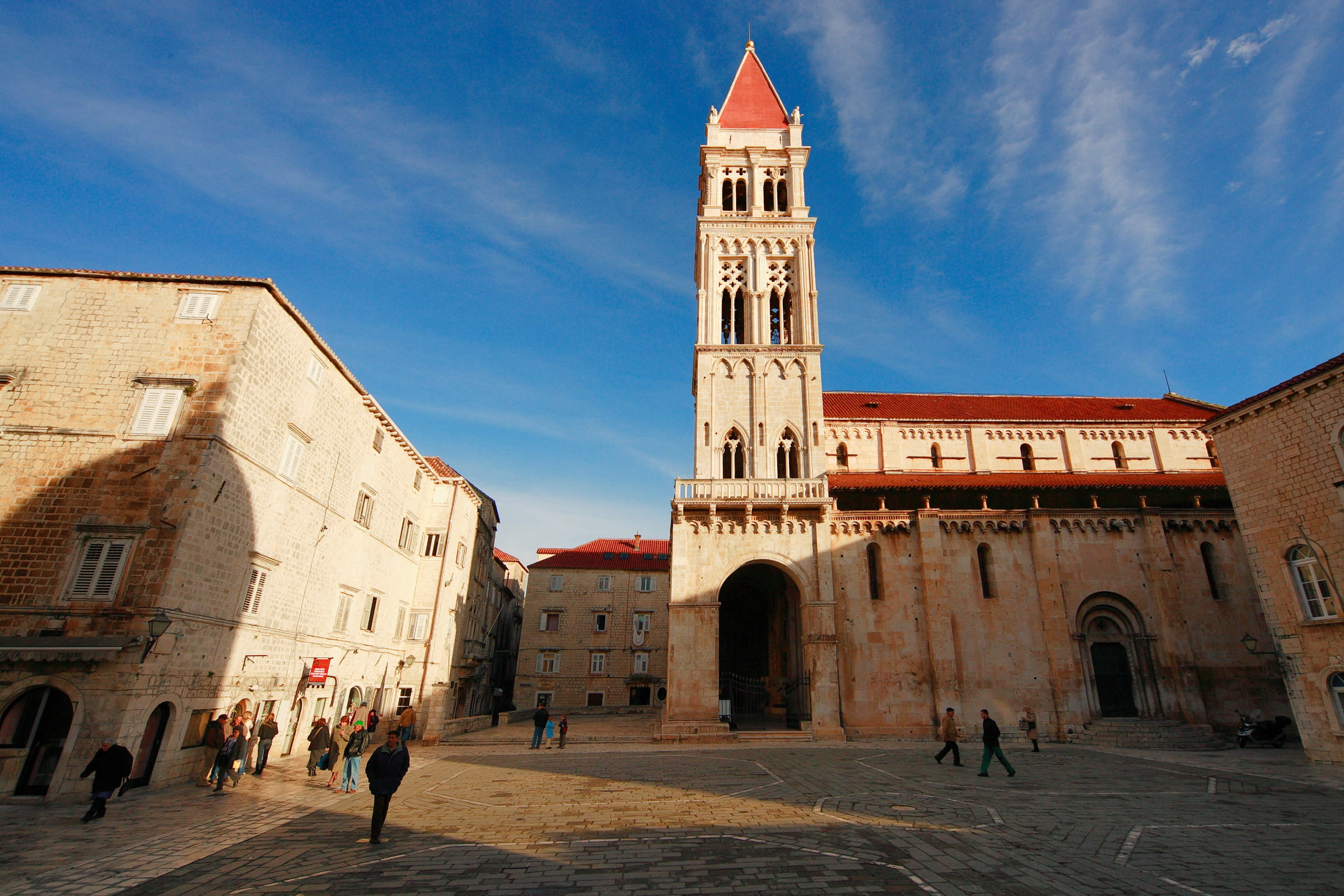 Trogir by Mario Romulic
Trogir by Mario Romulic
We have another appearance by Alberto Fortis who shares a warning: don’t get scammed on your travels! After two pages of musings on marble and its various properties, he says:
As I searched in vain around Trogir to find the famed marble, someone showed up who wanted to abuse my lack of guile by presenting me with a piece of Carrara marble as if it were taken from the nearby hill of St Elijah, where you can find old quarries whose marble isn’t rough at all, but is still far from the refined marble of Carrara.
No one's taking Fortis for a fool!
A traveller must always keep their guard up, as I have, before they draw conclusions based on other people’s claims. I.e., they should go directly to the site in question or at least threaten to do so in spite of all difficulties; that is how you uncover lies.
A marble-related crisis isn’t a situation a lot of us are likely to find ourselves in these days, but fine advice nonetheless.
 The portal of Trogir cathedral by Mario Romulic
The portal of Trogir cathedral by Mario Romulic
He adds a few favourable impressions of Čiovo island:
The island’s climate is truly very pleasant, the air perfect, oil, grapes and fruit excellent, the sea rich in fish, the port spacious and shielded. And its surface isn’t so small that a nobleman couldn’t comfortably walk or ride around it.
Good to know.
***
Before we go on to Split, a note on the hinterland by Marcotti, an Italian writer visiting in the late 1890s:
Those who want to be more in control of their time while travelling in the Dalmatian hinterland will prefer to travel by horse, but will have to get accustomed to a common lack of comfort in regards to accommodation and food: pecorino cheese, stale bread; plum brandy to drink. Corn polenta, ham, roasted lamb, smoked mutton and wine are items of luxury.
***
I believe we’re all familiar enough with the splendour of the Diocletian’s palace in Split to skip the lengthy elegies about its magnificence. Instead, let’s see a few impressions of the town in general, starting with Marcotti:
The market is especially crowded on Monday and Thursday mornings. It is interesting to see how peasants and people from the outskirts of town are dressed: bright colours (blue, red and black), large pieces of jewellery, filigree, gold and silver buttons, chains, medals. Compared with the Morlach women, the women of Kaštela stand out with their elegance.
The countess gets philosophical:
A rosy and curly child, with a serious expression of a grown man, leads us through narrow streets in the ruins of the palace. There is something moving about this loyalty that leads men to live where their ancestors lived, be it within the crumbling walls of an ancient palace or next to a dormant crater that will sooner or later sow devastation and death around it.
![]()
And Spon was surprisingly won over by Split, having spent ten days not doing much other than sampling the local cuisine:
The time we spent in Split did not last us long, because we discovered something new every day and besides, the food was very good. The only downside was accommodation which was not very convenient, as we found but four bare walls.
Partridge only costs five sols there, and hare doesn’t cost much more. There is meat at the butcher’s for one sol a pound, and turtles the size of two fists for four or five sols. But more often than not we preferred to abstain from meat and eat those little trouts from Salona, of which Emperor Diocletian was so fond, that for fear of running out of them he had an express conduit made which brought them to his palace.
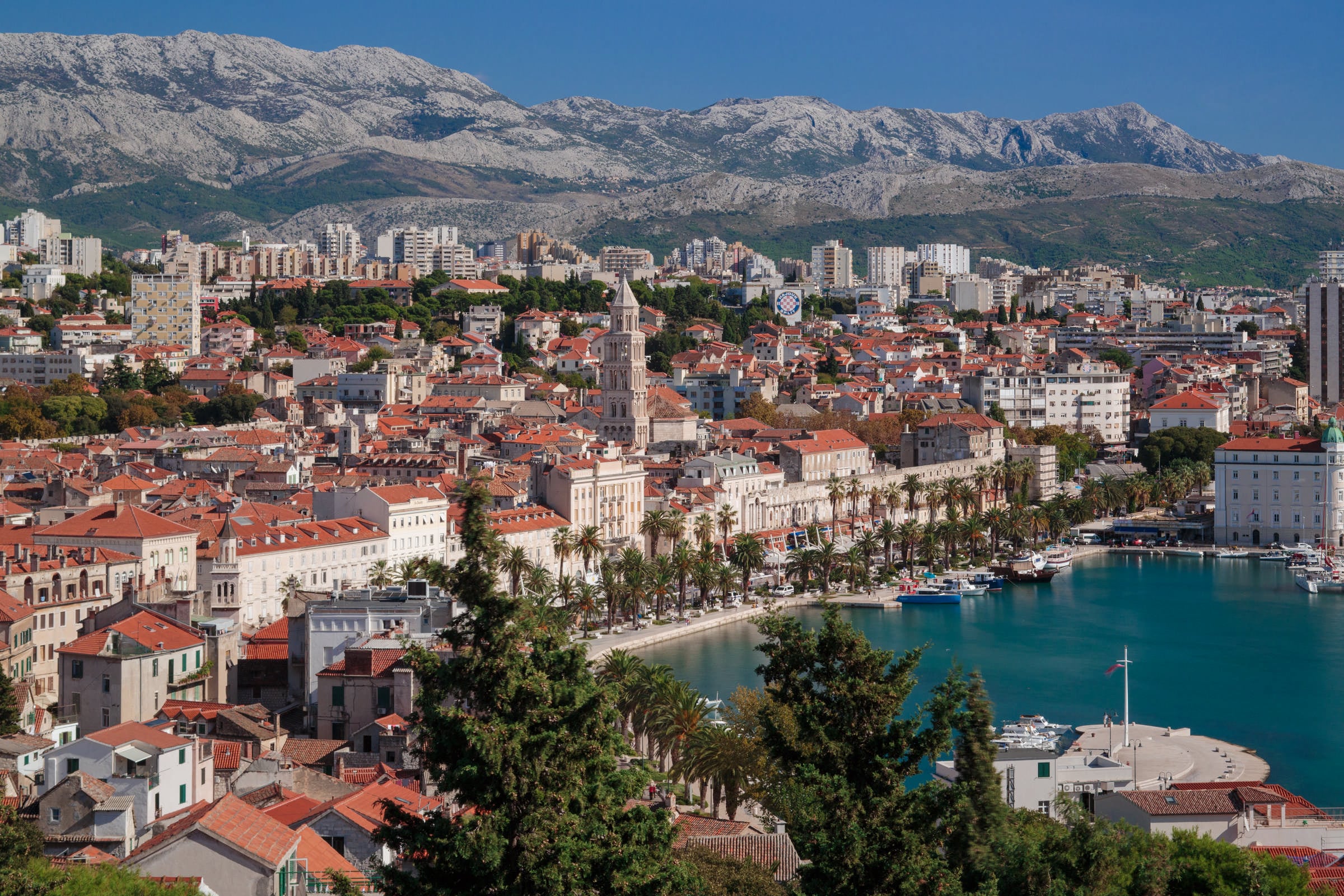 Split by Mario Romulic
Split by Mario Romulic
All of our brave travellers then went to see Klis. Marcotti offers some practical information:
From Split via Klis (2 hours) to Sinj (5 hours), superb road, but the postal service only operates twice a week. A permit from the commander’s office in Split is needed to visit the Klis fortress; it is not granted to ladies.
Rude.
It would take long to recall the whole of its glorious military history, he says about the fortress, then recalls it anyway. A history lesson later, he goes on to say:
The road, the gates, the barracks, they’re all modern; but the walls, the towers, the ramparts, all retain the picturesque charm of ancient military gear: the mosque was transformed into a warehouse. And there’s a beautiful view to boot. In the village, nestled on terraces below the fort, are several taverns.
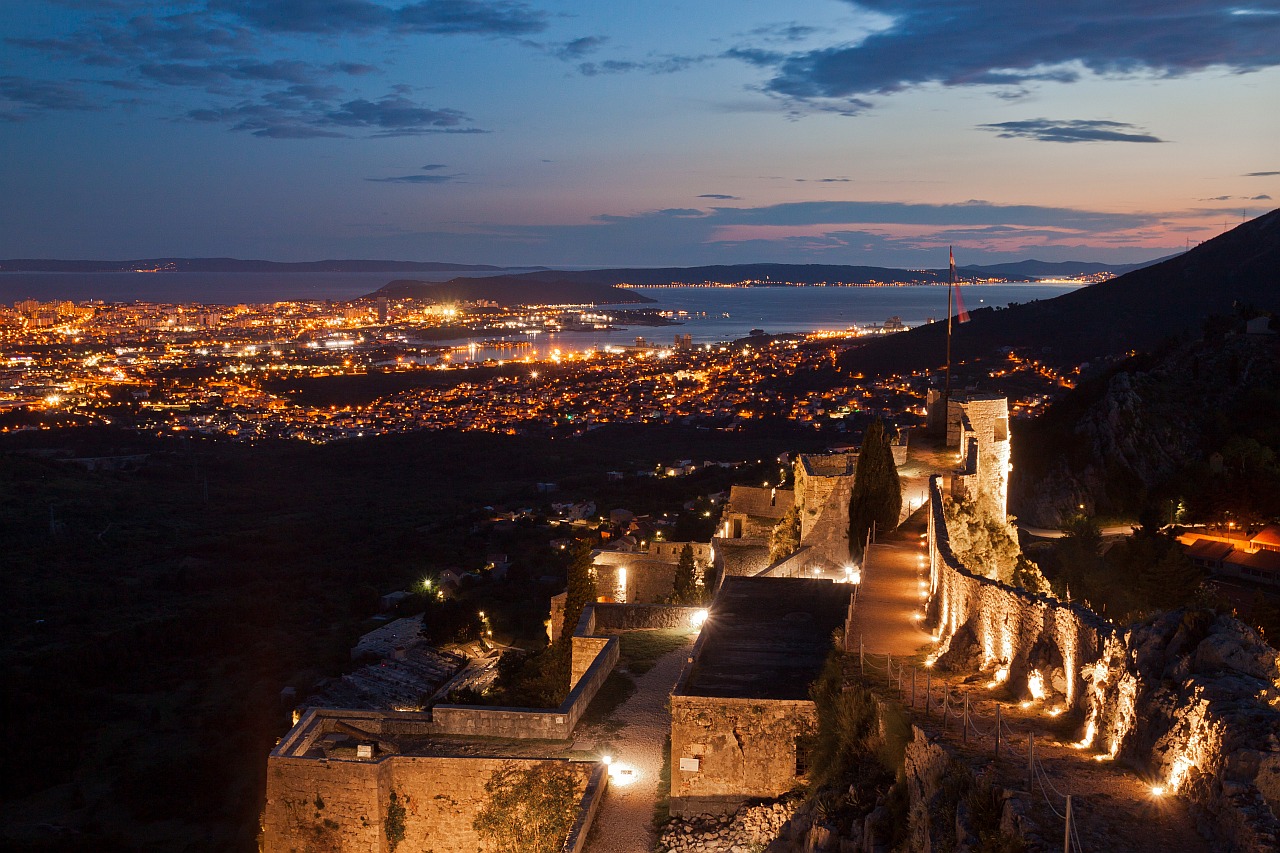 Kliss fortress
Kliss fortress
Countess Rochecantin:
The citadel of Klis, truly an eagle's nest which proudly dominates the valley. The rock it’s built on is surrounded by peaks which would seem inaccessible, if it wasn’t for little pockets of greenery bearing witness to the patient conquest of man over this rugged nature.
And then there’s Spon, bless his heart:
There’s a lack of water and it gets terribly cold in winter. I imagine it’s a harsh penance for a Venetian nobleman to serve here as an officer for two years. 2/10
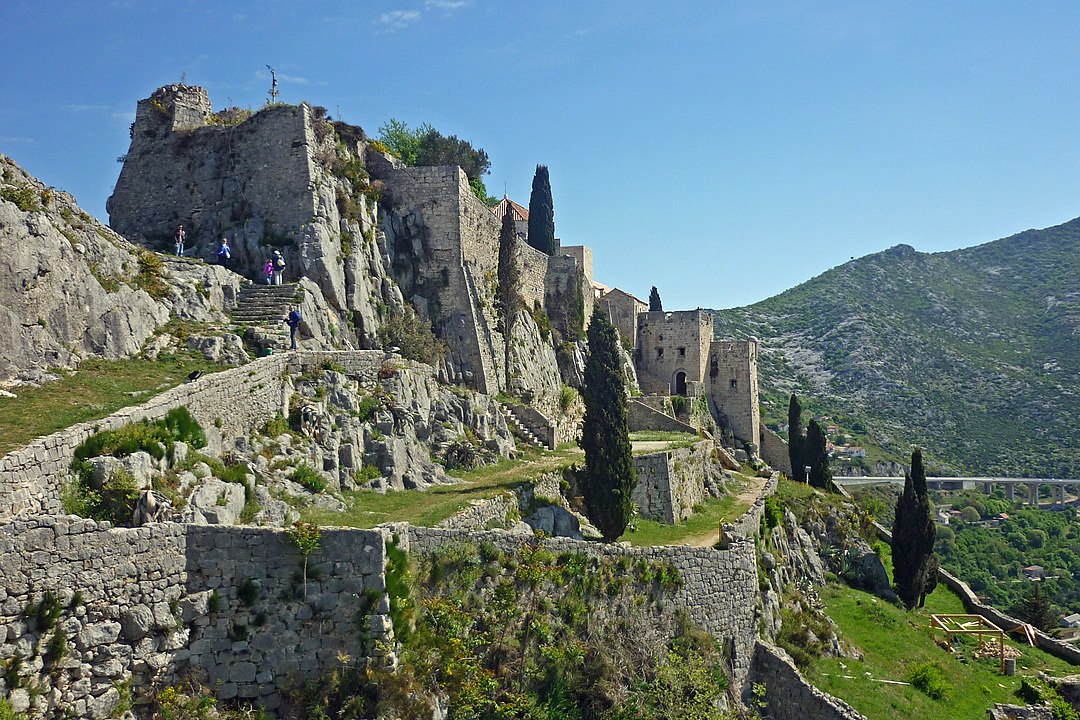 Kliss fortress
Kliss fortress
Marcotti offers a few pointers for towns and islands in the area:
At the mouth of the river Cetina, between Mount Biokovo and the sea is Omiš, a formidable ancient pirate nest. Ruins of the Mirabela and one other castle: excellent wines, pink muscat, even some dessert sparkling wines.
The man truly tells us what we want to know the most.
Šolta isn’t big: its chief town Grohote only has 1200 inhabitants. It’s been renowned for its honey since ancient times; the bees only suckle on rosemary.
Brač is the most important Dalmatian island, in terms of size, population and wealth. They produce vugava, an excellent prošek wine. (...) In the village Pučišće are quarries where stone was sourced for Diocletian’s grand construction in Split.
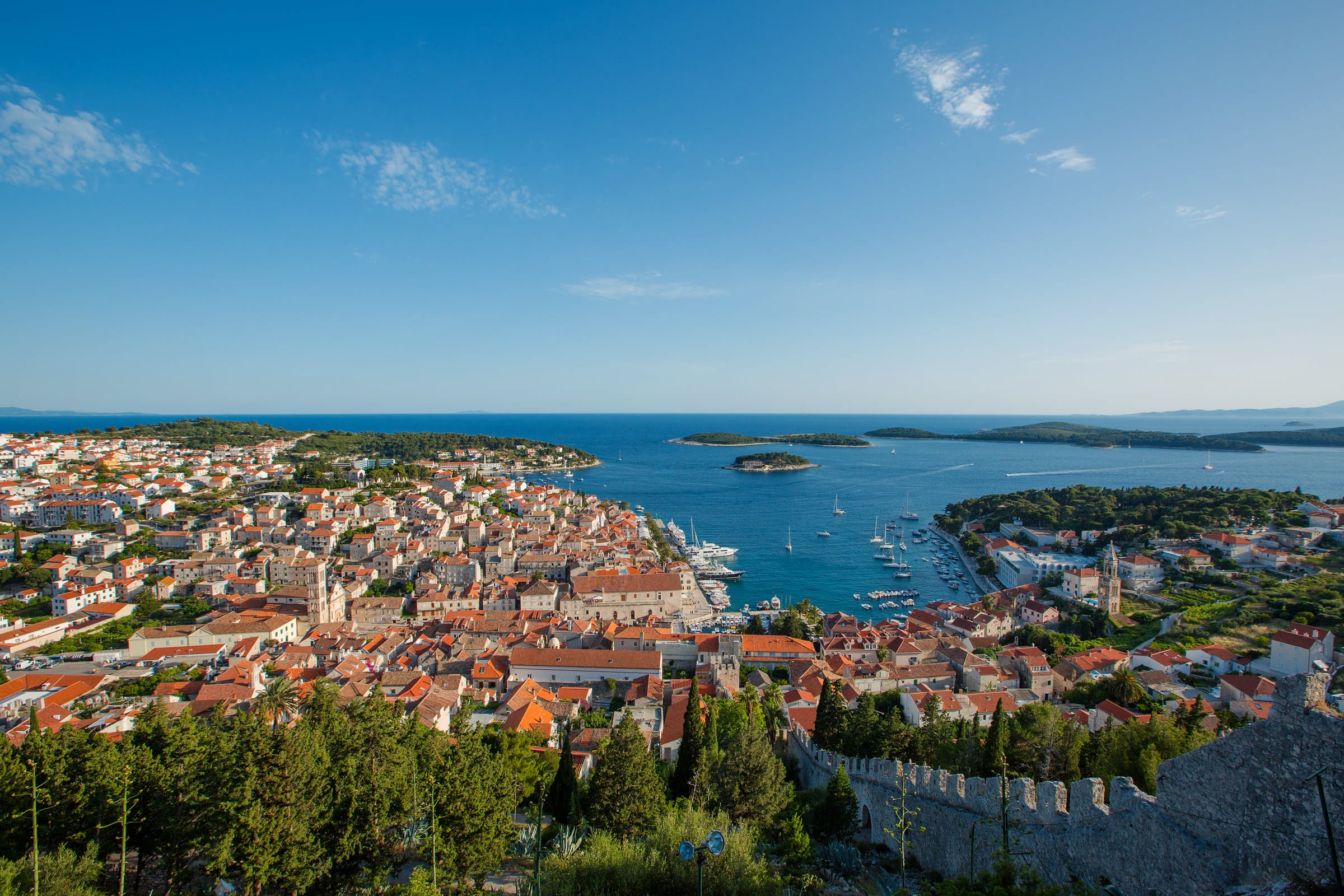 Hvar town by Mario Romulic
Hvar town by Mario Romulic
Hvar: shielded from bura wind by the island’s hills, and from sirocco wind by Pakleni islands, it enjoys a well-deserved reputation as a very favourable climate. Cypress, agave, carob and palm trees thrive there magnificently.
A particular thought stands out in this paragraph. At the time of his visit in the late 19th century, organised tourism was already in development in Croatia, notably in two destinations both mentioned here. Marcotti says:
If direct lines by sea between Italy and Dalmatia were properly established, Hvar town would be a highly recommendable winter destination for the Adriatic regions of the Kingdom, incomparably preferable to Opatija.
According to Spon, Hvar town was an inviting place even two hundred years earlier:
The people of the island, who are three or four thousand in number, have all withdrawn to the town of the same name so they can watch foreigners occasionally dock in their port. So they could receive them with more dignity, they have made there a beautiful pier of marble and stone blocks which lines the semi-circular port.
There is very good bread and very good wine, and plenty of sardines to whet the appetite, with which they also supply Italy and Greece.
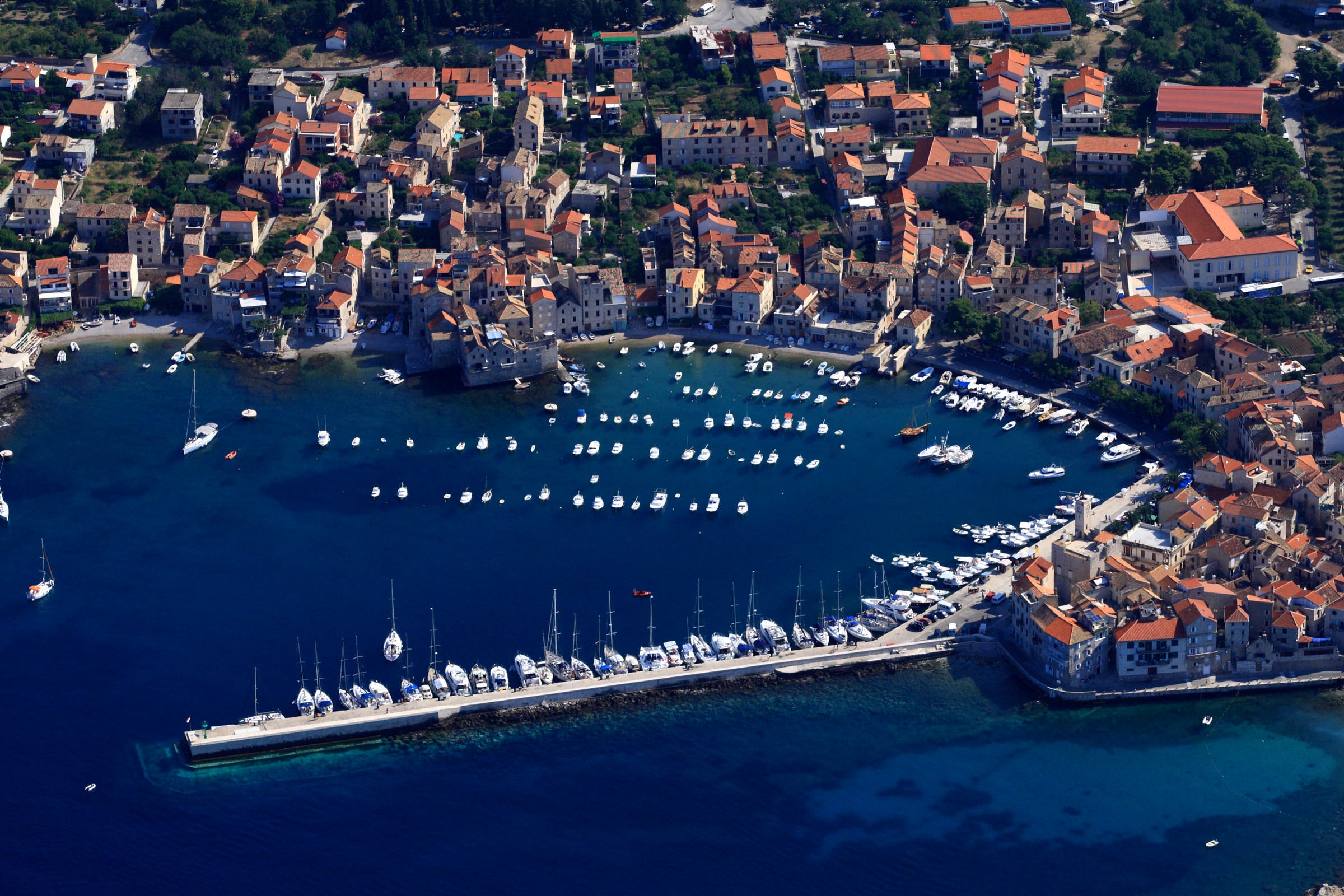 Komiža on Vis island by Mario Romulic
Komiža on Vis island by Mario Romulic
Vis: The island’s vegetation has a distinct southern character, with almond trees, figs, and palm trees. Some excellent wines are the opollo, the Margherita, the prosecco, the gripola, as well as vinegar and brandy. Sardines are abundant in Komiža; anchovies, mackerel, sea bream and snapper are found in all the waters around the island. The suckling lambs are delicious owing to the aromatic pastures of rosemary.
Spon also visited Vis island, but wasn't impressed with the sights:
I won't talk about the fortress, it's just a crow's nest that could be knocked down with ease from the nearby rocks. In the whole garrison there is but one simple soldier who performs the roles of Captain, Sargent and Porter, much like that of Plautus.
He goes to Korčula next, where he learns about jackals:
As this island is covered in woods, it is a haven for several wild beasts. Among them is a certain animal which I am told is built like a dog, but has the cry of a cat or a peacock. If one lights a fire at night near these woods, one can hear a great number of them shrieking and chanting their rabid song, such that those who have never heard them before mistake them for people yelling. It is also said that they dig up the dead to feed on them, and they are good for naught else, but to make some horrid furs out of them.
Next up: Dubrovnik, plus a few places we missed on our way south!
Sources for part II:
Jacob Spon, Voyage de l'Italie, de Dalmatie, de Grece, et du Levant, Fait és années 1675. & 1676., Tome I (Antoine Cellier le fils, Lyon, 1678)
Noé Bianchi, Viaggio da Venezia al S. sepolcro, et al monte Sinai (Remondini, Bassano, 1770)
Giuseppe Marcotti, L’Adriatico Orientale, da Venezia a Corfu (1899)
Alberto Fortis, Viaggio a Dalmazia, 1774 (Croatian edition: Put po Dalmaciji, Globus, Zagreb, 1984)
Comtesse de La Morinière de La Rochecantin, Croisière en Adriatique et en Méditerranée (1907)
Quotes translated from Croatian, Italian and French by the author of the article.
Belgrade-Zadar, Zagreb-Athens Summer Flights, 13 Freebird Dubrovnik Winter Charter Flights
February 3, 2022 - The latest flight news to Croatia as Air Serbia announces Belgrade-Zadar flights from June, Aegean Airlines launches Zagreb-Athens this summer, and 13 Freebird Dubrovnik winter charter flights will run from the end of this month!
Serbian national airline Air Serbia will re-introduce a regular flight between Zadar and Belgrade this summer, reports Croatian Aviation.
Namely, as of June 14, the Serbian airline will operate between Belgrade and Zadar. A few days ago, the same airline announced it was restoring the route to Rijeka.
The Zadar-Belgrade line was introduced in the 2019 summer flight schedule, and flights ran twice a week, every Friday and Sunday. The airline will also operate twice a week between the two cities this summer season.
Following the pandemic, the airline stopped traffic on this route and did not operate in the summer of 2020 and 2021.
ATR72 aircraft have been announced on the route, which has a capacity of up to 70 seats in the passenger cabin. There will be just under four thousand seats on sale between Belgrade and Zadar.
In the summer flight schedule, Air Serbia is planning regular flights from Belgrade to six Croatian airports: Zagreb, Pula, Rijeka, Zadar, Split, and Dubrovnik, and up to 18 weekly flights have been announced in the peak summer season.
Furthermore, Croatian Aviation reports that Aegean Airlines should re-establish a regular connection between Zagreb and Athens from mid-June this year.
The scheduled flights have been announced in the summer flight schedule, from June 15 to October 8 this year. Only two flights a week have been announced, every Wednesday and Saturday, but with A320 aircraft, which have a capacity of 180 seats in this airline's fleet.
Before the pandemic, Aegean flew to Zagreb several times a week, but at that time, DashQ400 aircraft with drastically lower capacity operated on the route compared to A320 aircraft.
Aegean Airlines will offer a total of 12,240 seats between Zagreb and Athens. In the summer of 2020 and 2021, this airline did not operate to Zagreb but exclusively to Adriatic airports. However, Aegean is currently not planning to return to Split, only to Dubrovnik.
The flight schedule is still subject to change, and it is to be expected that Croatia Airlines will also operate on a regular route between Zagreb and Athens (with a technical stop in Dubrovnik).
Finally, Croatian Aviation announced that the Turkish charter airline Freebird Airlines would introduce numerous charter routes to Dubrovnik Airport at the end of this month.
Namely, from February 21, this Turkish carrier will launch regular charter traffic on 13 lines to and from Dubrovnik Airport from:
Vienna,
Berlin,
Brussels,
Dusseldorf,
Frankfurt,
Hannover,
Hamburg,
London,
Manchester,
Munich,
Marseille,
Paris,
Stuttgart.
On the 13 listed charter lines, Freebird Airlines plans to use A320 aircraft, with a capacity of 180 seats in the passenger cabin. As a result, this airline will generate many passengers on these routes, which is also much needed in the winter months.
Dubrovnik Airport published statistics for January this year, in which a total of 9,320 passengers passed through it, which is almost 50% of the traffic from January 2020 when the pandemic was not yet present in Europe. In January 2021, there were only 3,729 passengers in Dubrovnik.
For more on flights to Croatia and other travel announcements, make sure to check out our dedicated travel section.
Meteor Travelling 22 Kilometres Per Second Burns Up in Croatian Skies
January the 27th, 2022 - An impressive meteor travelling at 22 kilometres per second burned up in Croatian skies during the evening hours on the 25th of January.
When it comes to freak natural events, we've had quite enough of them. From pandemics and earthquakes, the sight of a burning meteor hurtling at an unstoppable speed towards Croatia was the last thing most people wanted to witness on a quiet winter evening, despite how impressive it looked. Luckily, the meteor burned up in the atmosphere, leaving nothing of itself left behind on earth.
As Poslovni Dnevnik writes, the Croatian Astronomical Union reported that a meteorite glowing like a brand new moon burned up in Croatian skies at around 18:00 on the 25th of January, 2022, and according to preliminary results, nothing is left of it because it burned up completely in the atmosphere just northwest of Zadar.
''Considering the numerous reports and inquiries from people, we would like to inform you that a meteor with a level of brightness like a new moon with a magnitude of about -7, which was moving at a speed of about 22 kilometres per second, burned up in Croatians skies in the evening of the 25th of January at around 18:00,'' the statement from the aforementioned union said.
The stunningly bright meteor was recorded on its journey down to earth by the cameras of the Croatian, ie the Global Meteor Network.
According to the calculation done of the orbit, the meteor which burned up in Croatian skies close to the area of Zadar was sporadic, meaning that it didn't belong to any currently known meteor swarm, and it originated from the asteroid belt between the planets of Mars and Jupiter, which lie at distances of 330.13 million kilometres and 871.25 million kilometres from Earth, respectively.
For more, make sure to check out our dedicated lifestyle section.
2 Polish Lot Zadar Lines, Brussels Airlines Split and Dubrovnik Flights for 2022 Summer
January 19, 2022 - The latest flight news to Croatia as two Polish Lot Zadar lines will return this summer, and Brussels Airlines Split and Dubrovnik flights have been announced from April.
Polish national airline, LOT Polish Airlines, will resume traffic between Zadar and Rzeszow, the largest city in southeastern Poland, in the upcoming summer flight schedule, reports Croatian Aviation.
Namely, LOT has announced on its official website that the Zadar-Rzeszow line, a city in southeastern Poland with just under 200,000 inhabitants, will return this summer. This route was introduced by the Polish airline in the summer of 2020, and regular operations also took place in the summer flight schedule in 2021.
Flights between the two cities will run once a week, every Saturday, starting on June 18, and the Polish airline plans to use DashQ400 aircraft with a capacity of 78 seats.
In addition to the regular route from Rzeszow, LOT Polish Airlines will operate to Zadar Airport on a regular route from its main hub - Warsaw.
Flights between Warsaw and Zadar should start on Saturday, April 30. Larger capacity aircraft, such as the Embraer E195, which has a total of 112 seats will operate on this route.
Like other airlines, LOT Polish Airlines is currently working on finalizing the summer flight schedule, so in the coming weeks, we will know the official 2022 summer flight schedule.
Furthermore, Croatian Aviation reports that Brussels Airlines has announced its 2022 summer flight schedule, which includes two Croatian airports - Split and Dubrovnik.
Although the airline was expected to increase the number of weekly rotations to Croatia, judging by the published schedule for the summer season, this will not happen.
Namely, the Brussels - Split - Brussels line has been announced from Saturday, April 23 to the very end of the summer flight schedule, Saturday, October 29. Two flights a week are currently announced on Saturdays, both on Saturdays, offering 642 seats on its A319 and A320 aircraft on a weekly basis between the two cities.
The Brussels - Dubrovnik - Brussels line is on sale from April 2, and flights are announced once a week, also on Saturdays. Unlike flights to Split, the route to Dubrovnik should run until October 1. Airbus A319 aircraft with a capacity of 141 seats in the passenger cabin has been announced between Brussels and Dubrovnik.
Brussels Airlines has previously confirmed that it will not return to Zagreb International Airport, which was expected given that Ryanair has introduced a regular route between Brussels Charleroi Airport and Zagreb, and Croatia Airlines operates from the main Belgian airport from Zagreb. This year, Brussels does not plan to operate to Zadar Airport, but only to keep seasonal operations to Split and Dubrovnik.
For more on flights to Croatia and other travel announcements, make sure to check out our dedicated travel section.
TUI Zadar Flights Added to Croatian Destinations, Austria Airlines Zagreb Flights Temporarily Suspended
January 16, 2022 - The latest flight news to Croatia as TUI Zadar flights are on the list of Croatian destinations this summer, while Austria Airlines will temporarily suspend Vienna-Zagreb flights from Monday.
TUI fly Belgium, a member of the well-known TUI group specializing in organized tourist trips to a number of well-known leisure destinations, including Croatia, has announced a number of destinations in the upcoming 2022 summer flight schedule.
In the past summer season, TUI Group planes flew to Pula, Dubrovnik, and Split, and this year, according to the announcements, we can expect them in Zadar as well, reports Croatian Aviation.
Just like last year, TUI has strengthened its network of destinations this year by adding four new airports to its list.
The list of airports for 2022 according to which TUI fly Belgium plans to operate along Zadar includes Havana (Cuba), Aruba (Netherlands Antilles), and Ohrid (Northern Macedonia).
According to currently available data, flights from Brussels (BRU) to Zadar have been announced from April 23 to October 1, and TUI fly Belgium aircraft on this route should operate twice a week, on Wednesdays and Saturdays.
Croatian Aviation adds that although the summer season and the whole of 2021 were very challenging for the airline industry, it seems that this airline believes that the 2022 summer season should be more successful, so in the announcement for the upcoming season, all destinations from 2021 remain on the list of destinations, including four new ones.
In 2022, TUI fly Belgium plans to offer 95 destinations and 168 routes, and flights should take place from airports such as Brussels, Ostend, Antwerp, Charleroi, Liège (Belgium), and Lille (France).
Furthermore, Ex Yu Aviation reports that Austrian Airlines will temporarily halt Vienna-Zagreb flights from Monday, for the third time in the last two years. The service should be suspended until at least February 28.
"Due to the rapidly evolving pandemic situation, during the second half of January and part of February, certain flights have been cancelled, but the majority are on sale from February onwards. Zagreb Airport is in contact with airlines across the world. However, due to the confidential nature of such contacts, we cannot share any more information at this time," Zagreb Airport said.
Croatia Airlines will continue to fly between Vienna and Zagreb with three weekly flights planned.
For more on flights to Croatia and other travel announcements, make sure to check out our dedicated travel section.
1800-year-old Roman Goddess Venus Statue in Zadar Discovered at Future Hotel Site
January 15, 2022 - A Roman goddess Venus statue in Zadar has been discovered at the construction site of a future hotel. It is about 1800 years old.
A statue of the Roman goddess Venus was found on the construction site of a future hotel in the center of Zadar, about a meter high, preserved from the knees to below the chest, made of marble, and about 1800 years old, reports Slobodna Dalmacija.
"Academician Nenad Cambi, our greatest expert on antiquity, believes that it is most likely a statue of the goddess Venus. Its full height was about two meters, and it was probably on a pedestal in the atrium of this ancient urban villa where we are now," said Smiljan Gluščević.
A statue of the Roman goddess of beauty, love, fertility, and sexuality was found at a depth of about two meters, and stone fragments of a large base, most likely a crown, were discovered in the immediate vicinity.
"Such examples of ancient plastic are very rare in our country. However, a similar remnant of a statue of Venus exists in the Archaeological Museum in Split," said academician Cambi, and Gluščević added:
"We found a precious and rare statue, which will be known more after its cleaning and conservation."
As soon as Venus was taken out of the earth, it was clear to archaeologists that they had discovered a "sensation." It was immediately separated from other artifacts and transferred to the depot of the Homeland Museum in Biograd na Moru. An agreement was signed on the disposal of all finds at the investigation site.
Smiljan Gluščević points out that the statue is attractive and has several details.

Smiljan Gluščević
"On the left leg is a broken part of someone's hand, on the right thigh as if it were someone's fingerprints. Some "prints" can also be seen near the groin and on the part of the body below the chest ... Archaeological analysis should explain these things. Academician Cambi believes that part of the hand on the left leg most likely belongs to the god Mercury, with whom Venus is often iconographically associated.
These are all, I emphasize, preliminary knowledge, but it is undoubtedly a special find and statue that would be nice to present in a new building," said Gluščević, who also interpreted the archaeological context in which Venus was found.
"It was, therefore, most likely one of the sculptures from the atrium of this ancient urban villa. A marble floor of about 80 square meters was also found where the statue was discovered.
It extends to the east, south, and north, so we don't know the true dimensions of that central part of the villa. But considering other finds - an 11-meter-long canal for sewage, the remains of an ancient wall lined with gray marble tiles, and the remains of a black-and-white mosaic covering an area of some four square meters - we can say that it is a rich urban villa between the second and fourth centuries, which very likely had a floor."
The location of the villa and the details of the mosaic coincided with the results of research by Professor Boris Ilakovac 60 years ago. Before constructing the neighboring building of Božidar Rašica, he researched the foundations of buildings demolished during and after the Second World War.
Professor Ilakovac found two villas in a row there; they touched each other's outer walls and had an identical mosaic decoration in the atrium. All this tells us that here, a hundred meters from the ancient Forum, several representative residential buildings were later, possibly in the early Middle Ages, demolished and only now being revealed in their full beauty.
We have also discovered several medieval walls, but it is too early to talk about their interpretation. Nevertheless, this is proof of the continuity of urban life on the Zadar Peninsula. Apparently, these villas were located within the ancient insula, possibly created before Christ, and divided by cards and decums where today's streets in this part of the city pass, with an average size of 40 by 20 meters," explains Gluščević.
Other interesting inventions are fragments of ancient and Byzantine pottery that probably arrived there between the fourth and sixth centuries. Fragments of luxury tableware from North Africa that do not belong to the time before the third century have also been found, and some could be dated to the fourth and fifth centuries, respectively.
If the owners get permits, and if they wish, these artifacts could be found in the window of the future hotel.
"It is difficult to talk about it because it does not depend on me but the conservators and investors of this facility. But, as an archaeologist, I would love to see a hotel display case with findings, to see the genius loci, the historical stratification of the place, and I think that would be attractive to visitors.
In addition, I believe that the found remains of the mosaic could be taken out and presented somewhere because today there is a developed technique for such a thing," he emphasized.
The final word will be given by the conservators, who will determine the conditions for protecting the location and construction for the investors of the hotel facility after the archeological report. That is, what will remain buried underground, and what may be presented.
"We archaeologists would always like everything to be seen, but we know that this is not possible, especially in cities such as Zadar, where you have an archeological site on every inch of land," concludes Smiljan Gluščević.
Smiljan Gluščević is the former director of the Archaeological Museum in Zadar, an expert in antiquity, and one of Croatia's most important underwater researchers. He conducted field research along the entire Adriatic coast and islands until his retirement five years ago.
Gluščević was the first professionally employed underwater archaeologist in the former Yugoslavia, leader of the international team for extracting Apoxyomenos in the sea near Lošinj, and the only Croatian member of the scientific committee "Archaeologia Maritima Mediterranea," a renowned international journal of underwater archeology published in Pisa and Rome.
Three years ago, as the crown of his research, pedagogical and academic work, he published the first Croatian university textbook in underwater archeology. He worked at Požarište for the private archeological company "Arheologija Art" from Zadar.
Among the numerous fragments of pottery found in the drainage canal, Gluščević discovered a more significant amount of so-called tubules. These hollow ceramic bricks served as "central heating" pipes in ancient villas.
The tubules were arranged inside the wall, and warm air passed through them, which speaks volumes about the luxury in which the people of Zadar enjoyed their villas overlooking the sea.
For more, check out our dedicated lifestyle section.
Zadar Presented Its Bronze Model of the City with Special Features
January 11, 2022 - The city of Zadar presented its bronze model at the end of last year, being the last city to have one and thus joining others such as Zagreb, Split, Dubrovnik, Šibenik, or Karlovac. The sculpture seeks to promote the cultural heritage of the city and has special features.
At the end of last year, the city of Zadar presented its bronze model, a sculptural reduced spatial representation of the historic core of the city that was set up on Bedemi, reports Turističke Priče. The aim of setting up this interactive sculpture is to contribute to the promotion of the UNESCO-protected immovable cultural heritage of the city of Zadar, by enabling a new concept of cultural presentation.
Zadar joins cities such as Zagreb, Split, Dubrovnik, and Šibenik, which have also placed a model of the city in public space. But Zadar has also taken a step forward. Thanks to a sound installation in the bronze model, it also counts with a sound background, more precisely sounds characteristic of Zadar, such as those of the sea organ.
As part of the project, signalization and interpretation were also set up and show visitors where they are currently, and the facilities are adapted to visually impaired people, making Zadar now one of the most famous and attractive tourist destinations to be accessible for people with disabilities.
The bronze model is placed on a metal base in the shape of waves and it is the work of academic sculptor Damir Mataušić. The model above the National Museum is 3 meters long and 1.5 meters wide and is made of cast brown patinated bronze, while the relief surface of the sea is made of polished aluminum. The cost of making the sculpture amounted to 1.14 million kuna including VAT, and the funds were provided through EU projects.
The model of Zadar is certainly a new tourist attraction of Dalmatia that you should not miss, as it is lit by LED lighting at night and is the only model with six separate speakers from which you can hear different sounds, even those happening in the city at the moment.
To read more about lifestyle in Croatia, follow TCN's dedicated page.
Zadar City Library Announces New Programs and Activities for 2022
January 8, 2022 - By organizing various programs and activities, developing and encouraging reading literacy, and increasing the availability of books, the Zadar City Library continues to monitor the National Strategy for Encouraging Reading in 2022.
The network of the Zadar City Library includes five city districts (Central Library and branches Aleksandar Stipčević - Arbanasi, Bili Brig, Crno and Ploča), the islands of Olib and Silba (library hospitals), a library station in the city district Bokanjac.
Considering that the library has the status of a county main library, the wider continental area of Zadar County has been covered, since 2007, by a mobile library, Bibliobus, and includes 67 settlements with 77 stops.
As reported by eZadar, by organizing various programs and activities, developing and encouraging reading literacy, and increasing the availability of books, the Zadar City Library (GKZD) in 2022 continues to monitor the National Strategy for Encouraging Reading for the period from 2017 to 2022. Emphasis is on the continuation of the project for young people Get involved with books and start working on new premises - Youth Department and connecting the Library with the Youth Center building, the City Branch within the Providur Palace, and the beginning of the library station in Kožino.
In the area of the Providur Palace on the ground floor, a department of the City Library will be formed, whose book fund will be oriented to the heritage and culture of the city.
''In the especially challenging times of today, we are adapting to the digital world, promoting new technologies, new ways of accessing knowledge, promoting literacy, and reading in all forms, among which the classic paper form still plays a very important role. As our predecessors throughout history have created works in various materials and forms, librarians are finding solutions to provide knowledge in the environment of technology development and offer verified and reliable information to all users'', said director Doroteja Kamber-Kontić.
The Zadar City Library also deals with home delivery of books, performs the activity Ask Librarians (online reference service), helps children from low-income families learn, conducts a volunteer program Mentors for reading, promotes reading through the Croatian Book Month, and holds a computer course for retirees.
To read more about lifestyle in Croatia, follow TCN's dedicated page.
12 Ryanair Zadar Summer Flights Postponed Until Beginning of June
January 4, 2022 - The latest flight news to Croatia as 12 Ryanair Zadar summer flights have been postponed until June.
After announcing the temporary cancellation of 12 routes from Zagreb Airport, Irish low-cost airline Ryanair has postponed the start of operations on the same number of routes from the Zadar base, reports Croatian Aviation.
Ryanair had already announced the start of operations on almost all seasonal routes from Zadar Airport at the very beginning of the summer flight schedule (from the end of March this year), though this will no longer happen. Namely, on 12 international lines, Ryanair postponed all operations until the beginning of June. This airline did the same with the lines from the Zagreb base.
The following lines from Zadar have been postponed and have a new start date:
Zadar - Aarhus, from June 3, twice a week,
Zadar - Nuremberg, from June 2, three times a week,
Zadar - Bari, from June 2, twice a week,
Zadar - Bologna, from June 2, twice a week,
Zadar - Milan Bergamo, from June 2, twice a week,
Zadar - Turin, from June 3, twice a week,
Zadar - Maastricht, from June 3, twice a week,
Zadar - Gdansk, from June 4, twice a week,
Zadar - Vaxjo, from June 1, twice a week,
Zadar - Bournemouth, from June 4, twice a week,
Zadar - Liverpool, from June 2, twice a week,
Zadar - Manchester, from June 4, twice a week.
The two-month postponement is justified by the airline's low demand caused by the pandemic and the reintroduction of passenger restrictions across Europe.
If passenger restrictions remain in force as we approach the start of the summer flight schedule, there is no doubt that other airlines will be forced to modify their operations as well. As a result, there will be fewer weekly operations than planned or the complete cancellation of operations, as Ryanair has already done on 12 lines from Zadar for the spring of this year.
Croatian Aviation concludes by asking how this airline will continue to react to the reduced demand and whether it will additionally cancel flights from Zagreb and Zadar, adding that such moves do not instill confidence in existing and potential passengers.
For more on flights to Croatia and other travel announcements, make sure to check out our dedicated travel section.


